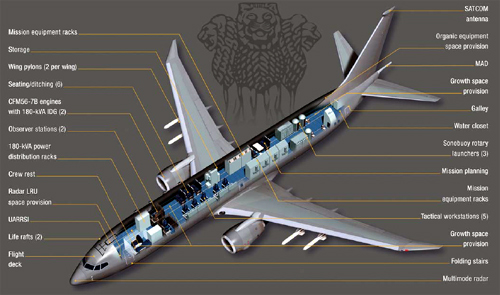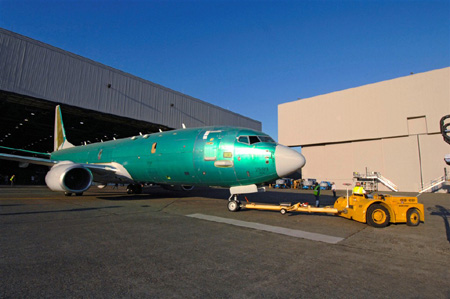|
New Delhi. The Indian Navy has signed a $ 2.1+ billion deal for eight
highly sophisticated P8-I Multi-mission Maritime Aircraft (MMA) with Boeing in
the biggest arms accord yet with the United States. Delivery of
the aircraft for operations should begin in about four years, or just around the
time the US Navy achieves Initial Operational Capability (IOC) after tests lasting
four years. The first flight of the aircraft is due in the last quarter of 2009,
“followed closely by delivery to the US Navy for the start of flight tests”
at Naval Air Station Patuxent River, Maryland, a Boeing spokesperson from the
company’s Airborne Anti-Submarine Warfare and Intelligence Programme told
India Strategic. Indian Navy spokesman Commander Nirad Sinha
confirmed the deal, signed here on January 1, adding that the government had accepted
the recommendations of the Naval Headquarters and that the Cabinet Committee on
Security (CCS) had cleared the proposal at its last meeting. It was apparently
part of the several proposals that the CCS cleared to strengthen coastal and sea-based
surveillance in the wake of the 26/11 Mumbai attacks by Pakistani terrorists,
who had hijacked an Indian fishing vessel to smuggle themselves into India in
a well executed commando operation. Boeing’s Vice President and Country
Head for Integrated Defence Systems (India) Dr Vivek Lall described the deal as
“unprecedented” as this is the first time that the US is sharing the technology
developed for US armed forces with another country at the same time. Canada and
Australia are among the other countries looking for this aircraft, he said. This
is the third big ticket military aviation deal with the US, the other two being
the acquisition of three Boeing BBJ VIP jets and six Lockheed Martin C 130J Super
Hercules aircraft for Special Operations. The combined value of these two agreements
however is lower than that of the MMA deal. The aircraft is much more than the
traditional LRMR, in that it would have a tremendous offensive capability to neutralize
threatening ships and submarines irrespective of their size and speed. The
aircraft can also serve as a seaborne command post if required.  DR
Lall declined to give details but said that the Intelligence, Surveillance and
Attack suites on board the Indian version designated Boeing P8-I should be the
same as those on board the US Navy version designated P8-A, for the simple reason
that it would have taken more time and costs to integrate another set of electronics
with different specifications on board the aircraft. DR
Lall declined to give details but said that the Intelligence, Surveillance and
Attack suites on board the Indian version designated Boeing P8-I should be the
same as those on board the US Navy version designated P8-A, for the simple reason
that it would have taken more time and costs to integrate another set of electronics
with different specifications on board the aircraft.
He described the Boeing
737-800 aircraft as “an entirely new machine, built around the standard aircraft
but developed as a hybrid with wings of Boeing 737-900.” Its wings can
now carry air to surface missiles and its lower front fuselage has been strengthened
as a bomb bay to accommodate Harpoon Block II missiles to engage and neutralize
large ships and submarines. The aircraft can also tackle small vessels in coastal
defence operations. The P8-I (I stands for India) would be able to scan
the waters for a continuous stretch of six hours up to a distance of 600 nautical
miles (approx 1100 km). The value of the deal is reported to be between
US$ 2.1 to 2.2 billion, inclusive of the warfare, intelligence and surveillance
systems as well as training and maintenance support. The deal for the aircraft,
along with onboard systems, is a commercial one, under a global tender with 30
per cent offset clause, mandating that much of the costs back in India towards
developing its defence industry. It was signed between Ms Preeti Sudan, Joint
Secretary (Maritime Systems) in the Ministry of Defence and DR Lall on January
1. The list price of a standard civilian Boeing 737-800 is US$ 70 million.
It’s not known what is the exact cost of the hybrid aircraft, but all told, the
cost of the spying and attack electronics that the aircraft would carry, is much
more than the aircraft itself. According to sources in Washington, weapons
like Harpoon II missile would be additional, and India would have to pay another
one billion dollars “but India would be assured of the most potent MMA technology
in the Indian Ocean region for years to come.” Their costs would depend upon what
the Indian Navy is looking for. Notably, while the deal for the aircraft
and onboard systems has been signed as a commercial agreement following a global
tender, the weapons would have to be acquired under a separate agreement with
the US government under its Foreign Military Sales (FMS) Programme. India
still has some issues pending with the US government on end use of US technology,
and all deals, including this one, would need Congressional approval to go through.
The US government has steadily been opening its doors for arms sales to India
ever since President Bill Clinton initiated better ties with New Delhi. President
George Bush apparently asked leading US arms manufacturers to woo India, and at
the International Defence Exhibition (IDEX) 2005 in February in Abu Dhabi, Raytheon,
Boeing, Lockheed Martin, Sikorsky and other giants welcomed Indian visitors, “offering
AMRAAM to SLARAAM and DamnRAMM.” This is what this writer had observed
at that time, and written in a newspaper in the Gulf. Indian armed forces
are interested in US technologies, particularly in electronic warfare and precision
engagement, but whether or not the deals mature would depend upon the new administration
of President Barack Obama. The P8-I deal is a package of the Boeing 737-800
hybrid aircraft, Raytheon’s advanced AN/APY-10 Synthetic Aperture Radar (SAR)
for tracking ships, submarines and small coastal vessels even on high speed, Northrop
Grumman’s Electronic Warfare Self-Protection (EWSP) suite, BAE Systems countermeasures
dispenser system, Smith Aerospace’s Flight and Stores (or Weapons) Management
System, and GESAFRAN’s powerful CFM 56-7 engines. Besides the crew,
the aircraft can have up to seven operator consoles to tackle various threats. Significantly,
according to DR Lall, a distinguished Indian origin aerospace expert settled in
the US, although the onboard technologies are the most sophisticated developed
so far, there is scope for future technology insertions due to the aircraft’s
open architecture. Weapons are made in the US by private companies, but
they are not allowed to sell either high technology systems or lethal weapons
under US laws. The US Government adopts its FMS programme to sell or supply weapons
to countries it wants to deal with. Top Indian Navy sources, happy at this
acquisition to replace an equal nuber of Soviet vintage Tu 142 Long Range Maritime
Reconnaissance (LRMR) aircraft, expressed the hope that there would be no hitch,
noting that the deal for such high technology would not have gone through if there
was any problem in the process. It may be recalled that a global tender
had been floated for new technology LRMRs in 2006 to look for a replacement of
its eight obsolete Soviet vintage propeller-driven Tu 142M aircraft. They consume
too much fuel, and despite some modernization, they are nowhere near the new technologies
that have emerged now.  The
US Boeing, European EADS and Russian firms were invited, but only the US and European
platforms met the Indian Naval Staff Qualitative Requirements (NSQRs). The Boeing
P8 won the race after a series of technical and weapons trials. The
US Boeing, European EADS and Russian firms were invited, but only the US and European
platforms met the Indian Naval Staff Qualitative Requirements (NSQRs). The Boeing
P8 won the race after a series of technical and weapons trials.
Boeing gave
demonstrations of the onboard systems using a Lockheed Martin P-3C Orion aircraft,
that the US Navy is gradually phasing out towards inducting the Boeing P8-A. The
Indian Navy is considering to acquire around 20 such aircraft gradually to secure
the vast coastal and ocean responsibilities against any threats to Indian territories
and maritime interests. According to the US Navy, which will get its first
P8A Poseidon aircraft this year for trials, the onboard systems are most modern,
and that the aircraft would “transform” its maritime patrol and reconnaissance
force and how it would “man, train, operate and deploy this futuristic technology. “The
P-8A will provide more combat capability from a smaller force and less infrastructure
while focusing on worldwide responsiveness and interoperability with traditional
manned forces and evolving unmanned sensors.” For the US Navy, the
aircraft is designated as P8A Poseidon, and the Indian version, being developed
specifically according to the Indian Naval Staff Qualitative Requirements (NSQRs),
is called the P8I. The aircraft is still under development, but it is the
standard practice in civil and military aviation that aircraft are sold even while
they are under development. Boeing 787 Dreamliner and Airbus A 380 are examples
in this perspective. The US Navy has ordered 108 of the Boeing P8-As. The
research and development of the P8 aircraft and its advanced onboard systems has
been funded by the US Navy to protect its aircraft carriers and other assets as
well as to hunt and attack nuclear and non-nuclear powered submarines worldwide
if they threaten the US security. This writer had the privilege of 'operating'
the ground-based simulator of this aircraft at Seattle during a visit by a group
of defence analysts invited by Boeing last year. We were told then by Boeing's
President for Integrated Defence Systems Chris Chadwick that if India opted to
buy this aircraft, it would perhaps be the first country to take advantage of
the "most sophisticated naval warfare technologies." In principle,
he had said, the US government had agreed to sell the aircraft to India. The
Boeing 737 is the most widely used aircraft in the world, and India has been operating
it for civil aviation needs for nearly 40 years, when its first versions were
introduced with Indian Airlines. Its maintenance accordingly would be easy,
given the large number of qualified engineers in India, and the commonality with
half a dozen similar aircraft with the IAF, including the three recently acquired
Boeing Business Jets (BBJs) for VIP use by its Communication Squadron. |